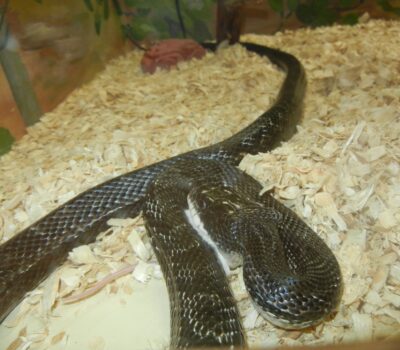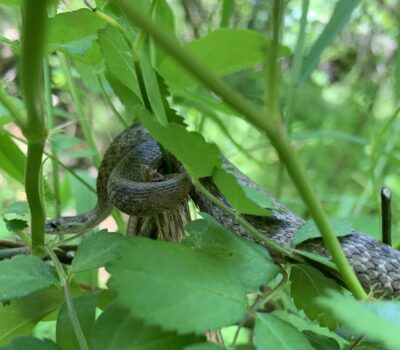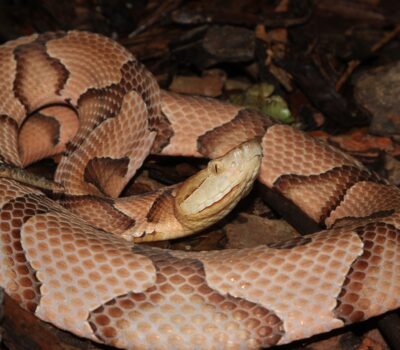Ask a Naturalist: Snakes Around Us
Snakes and Us
Summer brings people outdoors to enjoy the weather as well as native flora and fauna at their best. Walking, camping, and gardening are just a few ways to appreciate the beauty and gift of our natural surroundings. Getting close to nature also means increasing the chances of coming in contact with wildlife, such as snakes. Snakes have become the epitome of our fear of wildlife because of the cultural and social beliefs that snakes are out there to inflict harm on humans with their ‘slithery’ movement and ‘potent’ venom. This fear appears to have intensified with the easy exchange of negative perceptions about these docile creatures on some popular internet platforms. It is heartbreaking to see pictures of dead snakes that people brag about as a prize for killing another living being. Snakes lying dead on roads and trails due to intentional and unintentional killings are also saddening and, unfortunately, common sights. Our quest for perfectly manicured landscaping practices may have also contributed to our tendency to exclude any undesirable wildlife, not limited to snakes. But, if we get to the bottom of why snakes exist in the first place, perhaps we can overcome our negative perceptions and our fear of these meek reptiles, which have gotten a “bad rap” solely because of our selfish thinking and attitude.
Snakes do not have any vendetta against us. Snakes do not exist to inflict harm on other beings but simply to fulfill their ecological duty and are an integral part of the natural world. Let us shed some light on snake venom and snakebites, as these are the root of our unwarranted fear. First, venoms are not intended for animals other than a snake’s prey, such as mice and voles. Venoms, in fact, are an important digestive juice for snakes to disintegrate their prey for easy digestion; however, snakes will use it to ward off animals that encroach on their territory, including humans. Indeed, some snake bites are fatal and the reaction to a snakebite probably depends on your own physical response to a particular venom. Second, adult venomous snakes avoid injecting venom when they bite another animal for defense unless it is absolutely necessary, as wasting venom means depleting their digestive juice stock, which may prove fatal if they do not have enough venom to digest their prey when needed.
Keep in mind that most snakebites occur when people try to kill or capture them. Interestingly, they pose little or no threat when left alone. Third, not all snakes carry venoms. For example, out of 37 snakes found in North Carolina, 6 are venomous. Thus if non-venomous snakes such as a black rat snake, bites, chances are you will only feel a cut and soreness, which goes away after a few days. Further, biting is usually the last-resort defense mechanism for snakes. Snakes exhibit excellent camouflage, produce warning sounds (such as rattling), and spray musk when distressed before lunging to bite an intruder. As snake bite is synonymous with venom injection, our emotional reflex can overpower the actual physical response mimicking a venomous snakebite reaction even when a non-venomous snake bites. Learning about snake habitat/ecology, their behavior, the distinction between venomous vs. non-venomous snakes, and most importantly, finding ways to live alongside our most undesired neighbors is perhaps the only way to ensure our and their survival. The information I have compiled below will help you do just that and learn to become comfortable with this inevitable neighbor. Be sure to click the links included below to learn more about these and other native snakes.
Some Native Snakes and their Feeding Behavior
Snakes can be divided into four groups depending on their feeding habit.
- Envenomates are venomous snakes that inject venom to kill their prey. Some examples include Copperhead, Timber Rattlesnake
- Constrictors are non-venomous snakes that constrict and suffocate their prey before swallowing whole. E.g. Black Rat snake, Racer
- Serpentines are also non-venomous snakes that grab and shake their prey to death before swallowing it whole. Some examples include Northern water snake, Brown water snake
- Others are snakes that neither produce venom nor use violent force to kill their prey such as garden critters and small amphibians. E.g. Worm snake, Brown snake, Ring-necked snake
Captive snake photos from left to right: A captive king snake constricting a prey. A timber rattle snake swallowing an envenomated prey whole. A black rat snake swallowing its prey whole. Photos by Sau
Some native snake photos, from left to right: A brown snake, a rough green snake, and a racer. Photos by Sau.
The triad region is home to 25 different species of non-venomous snakes. The most commonly encountered non-venomous snakes are the Black Rat snake, Black Racer, Eastern Garter snake, Rough Green snake and Brown snake. They all have variable sizes, food, and habitat preferences. Black Rat snakes grow to be 5-8′ long and are expert climbers and strong constrictors, sometimes feeding on bird eggs and even chicken eggs. They are sometimes found wrapped around doors and window edges and go unnoticed due to their excellent blending features, even though they have dark coloration. Brown snakes, on the other hand, merely grow up to 18″, hide in hedges and shrubs and devour garden snails and slugs.
The two venomous snakes found in our area are Copperhead (Agkistrodon contortrix) and Timber Rattlesnake (Crotalus horridus). Widely distributed Copperheads are responsible for most venomous snakebites in our area, but these snakes are docile and usually bite only if stepped on or otherwise provoked. They have dark hourglass-shaped crossbands with a light center. Juveniles have greenish-yellow tail tips. Being residents of dense forests, Timber Rattlesnakes, on the other hand, are rarely encountered around homes and farms. They are heavy-bodied with dark blotches and wavy crossbands. They signal their presence by rattling their tail and defending their territory vigorously when aggravated. Both have diamond-shaped heads, but contrary to the common belief, it is not a reliable way to identify venomous snakes as more than half of the snake species can flatten their heads when threatened, and juveniles of some snakes, such as rat snakes, exhibit diamond-shaped heads. What’s more, juveniles of some snakes also exhibit patterns similar to Copperhead and Timber Rattlesnakes, confusing a casual observer, thus leading to unnecessary snake killings. What is common between both of these venomous snakes is that they are reclusive and blend in with their surroundings very well. Even if bitten, their bites are rarely fatal. As mentioned above, venomous snakes can’t waste venom on a large and inedible animal like a human that it can’t swallow whole. This so-called ‘dry bite’ is an important defensive and venom-saving strategy. Regardless, all snakebite victims should receive prompt medical attention to rule out envenomation (injection of venom).
Photo: Copperhead (Left) & Timber Rattlesnake (Right). Source: herpsofnc.org.
Learning More and Getting Involved
The Herps of NC website has information on all NC snakes plus other reptiles and amphibians if you are looking to learn more about them. You are also encouraged to visit the following websites if you want to contribute pictures and snake sightings that may be useful to add to the online databases.
- Herp Mapper- HerpMapper
- The North Carolina Herpatology Society- NC Herpetological Society
- NC Herpetological Society NC PARC- NC PARC
Avoiding Snakebites
There are several ways we can avoid getting bitten by snakes. First, as with all wildlife, snakes become active and resentful of intrusions when the temperature is above 74°F. If hiking outdoors in warm weather, wearing long sleeves clothes and sturdy boots can decrease the chance of snakebites. Second, using common sense and being vigilant is also important when in nature because snakes are unobtrusive and have excellent camouflage. Keep in mind that we are the ones encroaching on wildlife territory when venturing outdoors. Last but not least, it’s very unwise to try to capture or kill a snake, venomous or otherwise, unless you are a professional snake handler trying to remove or relocate snakes. Always seek professional help if you need to remove snakes from your property and choose people or services that will relocate them instead of terminating their lives, causing more harm than good.
Snakes are an important part of our natural surroundings. Without them, we may end up using immense amounts of toxic chemicals to kill harmful pests and inflict even greater environmental damage. Learning about snakes helps avoid contact that could result in an injury on both sides. Moreover, learning to live alongside could prevent people from carelessly destroying beneficial animals such as snakes because we just assume they might be dangerous. Before assuming snakes as bad actors and attempting to get rid of them, think of the bounty of our natural world, like clean air, water, plentiful harvest, and raw materials that we take for granted, and how all those are made possible. Like us, all plants and animals call this place home, and our interconnections keep all living things including us alive.
References:
- Foster S & Caras R. “Venomous Animals and Poisonous Plants”. Peterson Field Guides
- Martof BS, Palmer WM, Bailey JR & Harrison JR. “Amphibians & Reptiles of the Carolinas and Virginia”
- Powel R, Conant R, & Collins JT (1998). A field guide to reptiles & amphibians: eastern and central North America. Houghton Mifflin.
- Amphibians and Reptiles of North Carolina webpage. Herpsofnc.org. https://herpsofnc.org/







